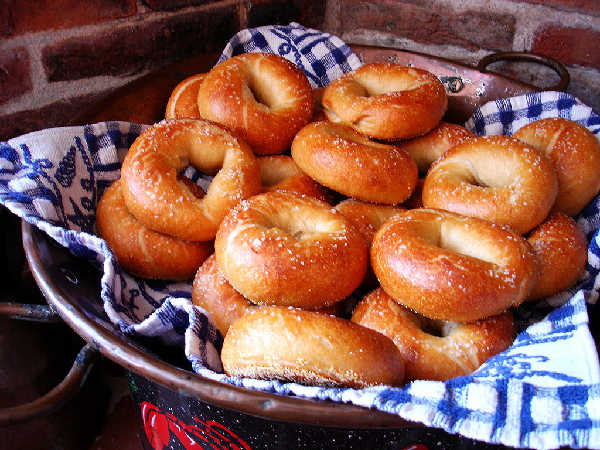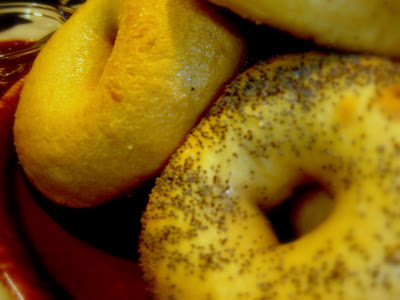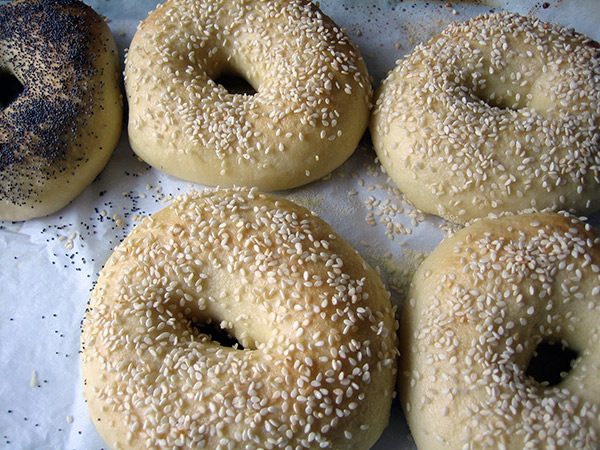


Many thanks to Susanfnp for posting a great sourdough bagel recipe based on Nancy Silverton's bagel recipe. She also provided a number of key tips as I made these. I posted photos of the first time I did these, and now I have some photos of my second attempt, as well as a spreadsheet with more details such as bakers percentages and preferment percentages.
Sourdough Bagel Recipe (revisited version)
Ingredients:
- 335 grams (12 oz) 90% hydration white flour starter
- 20 grams (0.6 oz) sugar
- 12 grams (0.4 oz) malt syrup
- 14 grams (0.6 oz) salt (I made salt bagels, so the salt in the dough is reduced to avoid too much salty flavor. Use 17 grams salt normally)
- 2.8 grams (0.1 oz) instant yeast
- 359 grams (12.5 oz) water
- 186 grams (6.5 oz) first clear flour (I used KA First Clear Flour. Substitute a high ash or whole grain flour - maybe rye, whole wheat, Heartland Mills Golden Buffalo, or just use white flour)
- 587 grams (20.5 oz) high gluten flour (I used KA Sir Lancelot High Gluten Flour. Substitute bread flour or other high protein white flour.) This time I corrected an error in the previous version and made the hydration lower, probably around 56%, which unexpectedly made the bagel dough stiff enough that it was a bit more difficult to shape the bagels. However, I used Susanfnp's suggestion to spray the surface of each 3 oz piece with a fine mist before shaping. This makes a world of difference.
Mix Dough - Day Before Baking
I had to mix and knead these by hand, since I have no mixer in this house. While reading the Nancy Silverton recipe, the idea seems to be to get a very stiff dough. I mixed all the dry ingredients in one bowl. I mixed the water, levain, and malt syrup in another bowl and then poured the wet mixture into the dry ingredients. Using a dough scraper I worked around the bowl a few times to get the ingredients initially mixed. I then vigorously kneaded the dough, using a traditional squeeze and fold kneading technique. This was not so easy with the stiff dough, but after about 5 minutes, the dough started to become elastic and fairly smooth, even if very stiff. After a few more minutes, the dough seemed fairly similar to what I had with the mixer in my first attempt at this recipe, documented in a previous blog entry. Since the dough is so dry, there is no need for dusting the counter with flour. In fact, you should avoid any extra flour, as the dusting can interfere with the smooth sheen of a proper bagel.
Shaping
Divide the dough into about 18 3 ounce pieces. Since the dough is so dry, it may develop a dry skin fairly quickly, so proceed smartly to the shaping stage. Don't dilly dally at this point, as the dough pieces will become too puffy quickly if they are allowed to sit at room temperature for very long. However, the pieces need to rest a short time, maybe 5 to 10 minutes, so that the gluten will be relaxed enough to shape the bagels.
I was more experienced and faster at shaping this time. The first batch of nine was placed on a jelly roll sheet, and immediately refrigerated. I discovered the next day that the first batch needed to rest on the counter for about 1/2 hour to ferment enough to come to the surface while boiling. The second batch, which had risen a while longer, was ready for boiling immediately out of the refrigerator the next morning.
If you have a fine mist spray (I have an atomizer meant for olive oil that I use for water), you can make shaping easier and avoid the dry skin, particularly on the pieces you shape last, by spraying a tiny amount of water on the pieces before you shape them.
To form the bagels, roll out an 8 inch rope shape with your palms. If the dough is too stiff or you make a mistake and want to start over, let that piece rest a few more minutes, and move to the next piece. Take the 8 inch rope and hold it between your palm and your thumb. Wrap the rope around your hand and bring the other end together with the end you are holding between your palm and thumb. You now have a "rope bracelet" wrapped around your hand. Rub the seams together on the counter to seal them, then take off the bracelet, which should look a lot like a bagel, hopefully. Stretch it out so you have a large 2.5 inch hole. It looks big, but it will shrink or even disappear as the dough rises during boiling and baking. The hole needs to be big looking compared to a normal bagel.
Place the bagels on parchment dusted with semolina flour on a sheet.
This time I used coarse corn meal, as I had no semolina available. This worked fine and seemed to make no difference to my results.
Cover with saran or foil or place the whole sheet in an extra large food storage bag (XL Ziploc is what I'm thinking here). The idea is to lock in moisture to avoid any dry skin forming yet allow room for some slight expansion as they puff up. Place the sheets in the refrigerator to retard overnight.
Boiling
Bring 5 quarts of water and 1 tablespoon of baking soda in a good sized stock pot to a boil. Place a bagel in the pot and make sure it floats to the top. If so, you can do 4-6 bagels at one time. They should only be in the water for about 20 seconds. Push them under periodically with a wooden spoon, so the tops are submerged for a few seconds. In my case, I never managed to get the bagels out before about 30 seconds were up, but they came out fine. If the test bagel won't float, lift it out with a slotted spoon, and gently place on a rack to dry and allow the bagels you have removed from the refrigerator (I did 6 of them at a time) to sit at room temperature for about 20 minutes and try again.
In fact, the batch I had shaped first the night before did sink to the bottom when I tested one. So, I left the first batch out for about 1/2 hour before it was ready. I then put them back in the refrigerator, since the baking and boiling process for the other batch was extending beyond 1/2 hour. I could tell the first batch was beginning to be ready, since I could detect a very slight puffiness in them after 1/2 hour.
The first batch floated immediately out of the refrigerator, probably because my second batch were formed and shaped after a rest of about 20 minutes while I was working on the first nine the previous night. Except for letting the first batch rise on the counter for 1/2 hour, I kept the bagels waiting to be boiled in the refrigerator to avoid any excessive rising. If you let them rise very much, they will puff excessively and become more like a bun than a bagel.
Dip in Seeds
Make plates of seed beds. I made three seed beds. One was 2 parts caraway seed, 1 part anise seed, and a pinch of salt. Another was 2 parts dill seed, 1 part fennel seed, and a pinch of salt. The last was poppy seed and a pinch of salt. I also made salt bagels, but those were done by just sprinkling a little kosher salt on some of them with my fingers.
Right after the bagels are removed from the boiling water with a slotted spoon, place them on a rack to cool for a few seconds. After they have cooled of slightly and dried enough not to ruin the seed bed with too much wetness, pick one up and place it round side down (the tops down), and gently press them into the seed bed. Pick them up and place them right side up on a sheet lined with parchment paper and dusted lightly with semolina flour or coarse corn meal.
This time I made only salt bagels. It wasn't convenient to get seeds, and my kids and I both love the salt bagels anyway. I just sprinkled a very, very light layer of kosher salt on them with my fingers while they were sitting on a rack just after they were boiled. The salt sticks to the wet surface, so you don't need to do anything but just sprinkle the salt on them. Careful, you can definitely put too much salt on them, even if you use a somewhat smaller amount of salt in the dough, as I did in this case.
Baking
Preheat the oven to about 400F. No preheat may work, but I'm not sure. It seems easy, from my limited experience, for them to rise too much. The result will be an open bread-like crumb, instead of the very chewy, more dense crumb expected in a bagel. So, I didn't risk a no-preheat strategy in this case.
If you have a stone, you can transfer the parchment paper on a peel to the stone and bake directly on the stone. I baked them for about 20 minutes at 400F. You can also bake them on the sheet.
Cool
Allow the bagels to cool.
Results
The bagels were chewy and delicious, as they were last time. However, I think the lower hydration was a definite improvement. I succeeded in getting a stiffer, drier dough this time. They had less tendency to rise excessively, even though I let them sit on the counter a little longer than last time. The resulting crumb was a little more dense and seemed just like the real thing this time. Last time, the slightly higher hydration gave me a slightly more open crumb, which seemed just a hair too soft and open like ordinary bread. This time, the crumb was dense and chewy and just right for a bagel.














